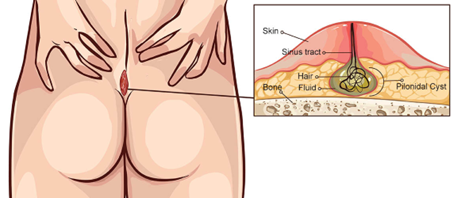Pilonidal sinus
Information for patients, relatives and carers
What is a pilonidal sinus?
This is an abnormal scarred tunnel in the skin between the buttocks, often associated with hair and skin debris.
They can discharge fluid from time to time, and can become troublesome if they block and cause an abscess.

What are the causes?
It is thought to be due to a disorder of the skin glands, and is more common in hairy people, those who spend time sitting (taxi or truck drivers, IT experts), and those who are obese.
Can it be treated?
Yes, though surgical wounds in this area can be difficult to heal.
Treatment aims are two-fold:
- to treat your symptoms
- to maintain soft tissue coverage over your tail bone.
What are the treatment options?
If the sinus causes you no problems, it is best to stay as you are, avoiding the risks of an operation.
The only way of curing this condition is with surgery. These are done as a day case with general anaesthetic.
There are a few different approaches:
- Lay open
A superficial sinus can sometimes be opened up to the surface with an incision, letting it heal from the base outwards. This leaves a scar.
- Endoscopic treatment
Some tracts may be suitable for keyhole treatment to clean out the tract. This avoid the need for large incisions, and recovery is usually very quick. This can reduce the discharge from the tract and cause it to scar and shrink.
- Excision and closure
Some tracts are large and complex, and may require excision of the affected skin and fat to treat them. The incision will be closed in a specialized fashion to reshape the contour of the buttock crease. This will leave a scar. You may have a small drain left in the wound for a week.
The main risk of this surgery is failure of the wound to heal, and can happen in up to 40% of cases. Healing is then very difficult, can take a long time, and may require further surgery to correct.
I’ve had an operation. How do I manage at home afterwards?
You will usually be sent home the same day, with instructions.
- It is likely that you will have local anaesthetic around the wound, so some areas may be numb. This will wear off, and it is important to take regular paracetamol and/or ibuprofen for the first 5 days.
- It is important that follow instructions about wound care, and when to have the dressing removed, changed or checked.
- You may go home with a surgical drain, which is a sterile tube allowing fluid to escape from underneath the wound. It is normally removed in clinic one week after the operation. If it falls out, then discard it.
- Follow instructions about activities to avoid. Sometimes you might be asked to avoid sitting for 2 weeks after the operation, particularly if you have had a large incision and flap reconstruction. In this case, lying or standing will be perfectly safe.
To access this information in another format or language
Including:
- Large print
- Easy read
- Audio
- Braille
Please contact the patient advice and liaison service (PALS)
Frimley Park Hospital 0300 613 6530
Heatherwood Hospital and Wexham Park Hospital 0300 615 3365

